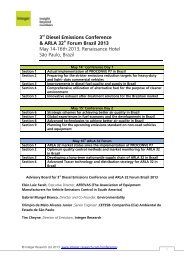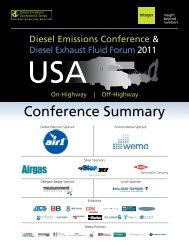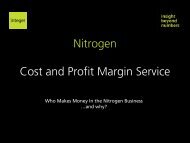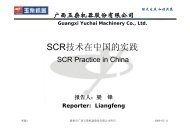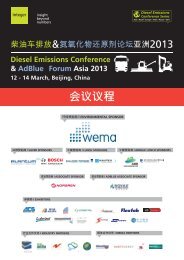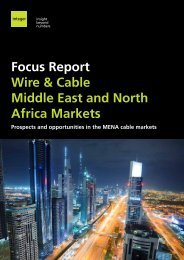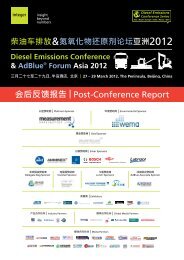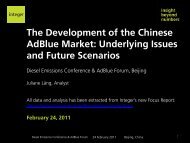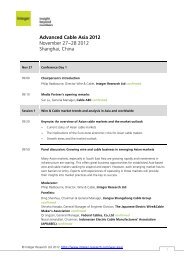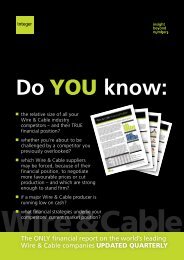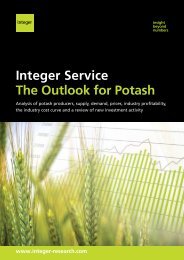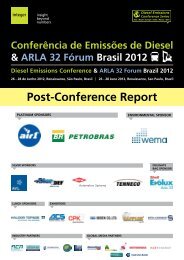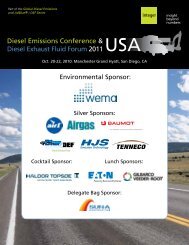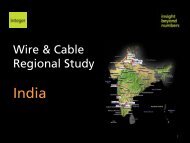AdBlue production - Integer Research
AdBlue production - Integer Research
AdBlue production - Integer Research
You also want an ePaper? Increase the reach of your titles
YUMPU automatically turns print PDFs into web optimized ePapers that Google loves.
insight<br />
beyond<br />
numbers<br />
2010 <strong>AdBlue</strong> ®<br />
Diesel Emissions Conference<br />
& <strong>AdBlue</strong> ® Forum Asia 2010<br />
March 23 - 25, 2010. Westin Hotel, Beijing, China
Measuring <strong>AdBlue</strong>® quality and understanding<br />
requirements of <strong>AdBlue</strong>® infrastructure<br />
Östen Andersson, Director Technical Support & HESQ<br />
Environmental & Speciality Products<br />
Diesel Emissions Conference & <strong>AdBlue</strong> Forum Asia 2010
1. Short Introduction<br />
2. Where does the contamination<br />
risk lie in the <strong>AdBlue</strong> supply<br />
chain<br />
3. Anti-Contamination Risk<br />
Measures Taken in<br />
<br />
<br />
<br />
<br />
<strong>AdBlue</strong> <strong>production</strong><br />
Bulk Logistics<br />
Filling of IBCs, Cans and<br />
Drums<br />
Dispensing Equipment<br />
4. VDA Quality Audit Programme<br />
Östen Andersson
1. Yara’s <strong>AdBlue</strong> solution : Air1<br />
• The leading <strong>AdBlue</strong> producer in the<br />
world<br />
• We offer a complete solution to meet the<br />
fleet operators, OEMs and oil majors<br />
individual requirements under the brand<br />
Air1 around the world, covering:<br />
– Reagent under the name <strong>AdBlue</strong> or<br />
DEF<br />
– Storage and handling equipment, of<br />
different sizes<br />
– Telemetry and services<br />
Östen Andersson
1. Yara is the world’s largest <strong>AdBlue</strong> producer<br />
4 Yara Production Plants centrally<br />
located for the core markets<br />
• Germany (Brunsbüttel)<br />
• The Netherlands (Sluiskil)<br />
• France (Le Havre)<br />
• Italy (Ferrara)<br />
• Unique back-up position and<br />
“safe harbor” for product<br />
availability<br />
• Strategic Air1 locations for local<br />
client needs, including dedicated<br />
terminals<br />
• Over 120 distribution depots<br />
across Europe<br />
Östen Andersson
1. Joint Venture between Yara and<br />
Sinofert – Purico in China<br />
• Yara and Sinofert formed a joint venture, Purico, to provide<br />
DeNOx solutions, including <strong>AdBlue</strong>, in China.<br />
• Based in Qingdao, Purico will spearhead Air1 marketing in<br />
China.<br />
Yara’s experience,<br />
know-how &<br />
expertise in Europe<br />
Sinofert’s <strong>production</strong><br />
capacity & distribution<br />
network in China<br />
Purico aims to be the leading <strong>AdBlue</strong> solution provider in China<br />
through Air1 concept.<br />
Östen Andersson
1. Sinofert – a strong partner<br />
• Major businesses include the <strong>production</strong>, import, export,<br />
distribution, wholesale and retail of fertilizer raw materials and<br />
products, as well as research and development and services in<br />
the field of fertilizer-related business and products.<br />
• With 2010 distribution centers spanning across 26 provinces,<br />
Sinofert is the largest integrated supplier of fertilizers in China.<br />
• Sales volume 16 mill mt, Sinofert owned stakes in 13 fertilizer<br />
manufacturers with a total capacity of 10 million tonnes, of which<br />
more than 2.5 million tons are urea.<br />
Östen Andersson
2. Multiple Contamination Risks in the <strong>AdBlue</strong><br />
supply infrastructure<br />
<strong>AdBlue</strong><br />
<strong>production</strong><br />
Plant & Storage<br />
X<br />
X<br />
Possible Contamination Risk<br />
Filling of IBC,<br />
Drums & Cans<br />
X<br />
Land<br />
Transport<br />
Intermediate<br />
Storage<br />
X<br />
Road<br />
Transport<br />
Customer<br />
X<br />
Transport<br />
Truck<br />
Rail<br />
Ship<br />
Land<br />
Transport<br />
X<br />
Road<br />
Transport<br />
X<br />
Storage<br />
Terminal<br />
X<br />
Road<br />
Transport<br />
X<br />
Storage at<br />
Customer<br />
site<br />
X<br />
Östen Andersson
3.1 Anti- Contamination<br />
Measures in <strong>AdBlue</strong><br />
Production<br />
Primary <strong>production</strong> from<br />
Urea Hot melt<br />
Secondary <strong>production</strong> by<br />
dissolving of solid Urea<br />
Östen Andersson
3.1 Principal Drawing <strong>AdBlue</strong> Production from<br />
Urea Hot Melt<br />
Closed system<br />
In principal no<br />
contamination risk<br />
Batch Control<br />
Batch Control<br />
Quality Control<br />
Conductivity<br />
Storage Tank<br />
Storage Tank<br />
Demineralised Water<br />
Quality Control<br />
Density<br />
Temperature<br />
Urea Hot melt<br />
Quality Control<br />
Example:<br />
Concentration<br />
Pressure<br />
Temperature<br />
Free Ammonia<br />
Static Mixer<br />
Cooling<br />
Filtration<br />
(Optional)<br />
Loading station<br />
Loading Pump<br />
Östen Andersson
Yara’s Urea Plant, Brunsbüttel, Germany<br />
Östen Andersson
3.1 There is low risk of contamination with<br />
<strong>AdBlue</strong> produced from Urea Hot melt<br />
• Main contamination risks<br />
– Unstable Urea <strong>production</strong><br />
• Control Measures<br />
– Control of process<br />
parameters<br />
– Stop of <strong>AdBlue</strong> <strong>production</strong><br />
at unstable conditions<br />
– Batch analysis<br />
Östen Andersson
3.2 <strong>AdBlue</strong> Production from Urea Prills,<br />
Dissolving increases the risk of contamination<br />
Batch<br />
Control<br />
X<br />
X<br />
Hopper<br />
Screw<br />
Conveyor<br />
Control System<br />
Concentration<br />
Temperature<br />
X<br />
Mixer<br />
Batch<br />
Control<br />
Storage<br />
Tank<br />
<strong>AdBlue</strong><br />
Batch<br />
Control<br />
Storage<br />
Tank<br />
<strong>AdBlue</strong><br />
Urea<br />
Big Bags<br />
1 000 kg<br />
Quality Control<br />
Conductivity<br />
X<br />
Demineralised<br />
Water Production<br />
Storage<br />
Tank<br />
Demin.<br />
Water<br />
X<br />
Transfer<br />
pump<br />
Transfer<br />
pump<br />
Loading<br />
Station<br />
Filter<br />
Filter<br />
Loading<br />
Pump<br />
Possible Contamination Risk<br />
Östen Andersson
Dissolving, Mixers and Hopper<br />
Östen Andersson
Dissolving; Storage of Urea Big Bags and IBC<br />
Östen Andersson
3.2 Multiple contamination risks for <strong>AdBlue</strong><br />
produced from Dissolving of solid Urea<br />
• Main contamination risks<br />
– Solid Urea quality<br />
– Demineralised water quality<br />
– Not dedicated equipment<br />
– Cross contamination with<br />
other products or ambient<br />
conditions<br />
• Control Measures<br />
– Incoming control of solid<br />
Urea<br />
– On line control of water<br />
quality<br />
– Control of process<br />
parameters<br />
– Dedicated equipment<br />
– Batch analysis<br />
– Routines to handle off spec.<br />
product<br />
Östen Andersson
3.3. Anti<br />
Contamination<br />
Measures for Bulk<br />
Logistics<br />
Östen Andersson
3.3 <strong>AdBlue</strong> Tanks and Loading area for Trucks<br />
Östen Andersson
3.3 Ship loading Tank and loading area<br />
Östen Andersson
3.3 Loading and unloading of <strong>AdBlue</strong> is an area<br />
with potential risks of contamination<br />
• Main contamination risks<br />
– Not dedicated transport<br />
vehicles<br />
– Not dedicated transfer<br />
equipment<br />
– Materials in contact with<br />
<strong>AdBlue</strong> not compatible<br />
– Open handling of <strong>AdBlue</strong><br />
• Control Measures<br />
– Dedicated transport<br />
vehicles<br />
– Inspection before loading<br />
and unloading<br />
– If not dedicated, a certificate<br />
of cleaning is mandatory<br />
including information about<br />
3 last products<br />
– Inspection after loading<br />
– Retention samples<br />
– Sealing of all openings<br />
Östen Andersson
3.4 Anti Contamination<br />
Measures for Filling of<br />
IBC, Drums and Cans<br />
Östen Andersson
3.4 Types of Packaged Product<br />
• IBC,1000 liter<br />
• Drum, 200 liter<br />
• Can, 5-10-20 liter<br />
Östen Andersson
3.4 Filling of IBC, Drums and Cans hold also<br />
contamination risks<br />
• Main contamination risks<br />
– Not dedicated filling<br />
equipment<br />
– Materials in contact with<br />
<strong>AdBlue</strong> not compatible<br />
– Returned IBC<br />
– Not cleaned<br />
– Reconditioned<br />
– Mix with off-spec product<br />
– Mix with wrong product<br />
– Filled in “uncontrolled conditions”<br />
– Emptying with dirty equipment<br />
• Control Measures<br />
– Dedicated filling equipment<br />
– Drums and Cans always<br />
one way package<br />
– Closed IBC with CDS or<br />
Micro Matric coupling and<br />
dip tube<br />
– Inspection procedures for<br />
returned IBC<br />
– Sealing of openings after<br />
filling<br />
Östen Andersson
3.5 Anti Contamination<br />
Measures for<br />
Dispensing Equipment<br />
Östen Andersson
3.5 Examples of IBC and Drum pumps<br />
Östen Andersson
3.5 Pumps for IBC and Drums risks of<br />
contamination<br />
• Main contamination risks<br />
– Not dedicated equipment<br />
– also used for other liquids<br />
– Materials in contact with<br />
<strong>AdBlue</strong> not compatible<br />
– Wrong handling by operator<br />
– Filling in wrong truck tank<br />
• Control Measures<br />
– Dedicated equipment<br />
– Equipment designed for<br />
<strong>AdBlue</strong> use<br />
– Closed IBC with CDS or<br />
MicroMatic coupling and dip<br />
tube<br />
– Warning signs, pictograms<br />
– Operating manuals<br />
– Training of operators<br />
Östen Andersson
3.5 Examples of Customer Dispensing equipment<br />
Dry Break Filling<br />
connection<br />
Östen Andersson
3.5 Risks for Dispensing Equipment at<br />
Customer sites<br />
• Main contamination risks<br />
– Materials in contact with<br />
<strong>AdBlue</strong> not compatible<br />
– Contamination during filling<br />
– Wrong handling by operator<br />
– Filling in wrong truck tank<br />
• Control Measures<br />
– Equipment designed for<br />
<strong>AdBlue</strong> use<br />
– Magnetic Filling nozzle<br />
– Dry Break Filling coupling<br />
– Warning signs, pictograms<br />
– Operating manuals<br />
– Training of operators<br />
– Regular Maintenance<br />
Östen Andersson
4. What is the VDA Audit Programme?<br />
• Verband der Automobileindustrie e.V. (VDA) is the owner of the name<br />
<strong>AdBlue</strong>® and to use the name you need a license<br />
• VDA has together with the main <strong>AdBlue</strong> producers and distributors in<br />
Europe developed an Audit Programme<br />
Minimum requirements on Management Systems<br />
in <strong>AdBlue</strong>® <strong>production</strong> and distribution chain,<br />
following the ISO standards 22241, part 1 – 3<br />
• The audits has just started in Europe and Yara is one of the first licensees<br />
that has been audited<br />
Östen Andersson
4. The VDA Audit Programme<br />
• The Audit Programme are divided in 7 sections<br />
– Basic Requirements<br />
– Production process<br />
– Production equipment<br />
– Sampling and testing<br />
– Documentation of test results and certification<br />
– Administration, tracking, batch traceability and labelling<br />
– Handling, transport and storage<br />
Östen Andersson
5. Summary<br />
• There are multiple contamination risks in the <strong>AdBlue</strong> supply infrastructure<br />
• The contamination risks could be reduced by relevant control measures<br />
– Follow the guidelines and recommendations in ISO 22241 part 1 to 3<br />
– Written procedures for all steps in the supply chain<br />
– Training of all parties involved in the supply chain<br />
– Use the right materials for all equipment in contact with <strong>AdBlue</strong><br />
– Use dedicated equipment for <strong>production</strong>, transport and dispensing<br />
– Audit all parts of the supply chain at regular intervals<br />
Östen Andersson
Östen Andersson<br />
Thanks for your attention



